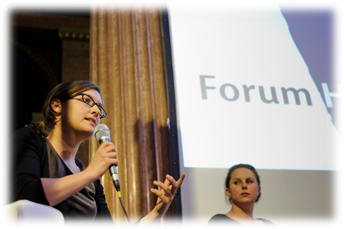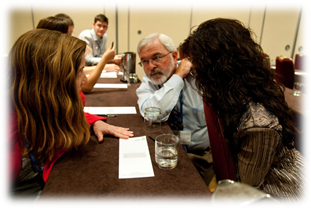This article specifically looks at how departments have been able to ensure their students feel that “any changes in the course or teaching have been communicated effectively” (NSS Question 14).
The communication of course and teaching changes is often a critical aspect of a student’s experience whilst at university. Sudden and unexplained changes to either, will more than likely cause frustration, confusion and stress, all of which will almost certainly result in a negative feedback through NSS in general as well as specifically for NSS Q14.
As part of this article, departments that have successfully scored some of the highest NSS scores for Q14 have provided information on the different communication initiatives they have put in place. This article is made up of three common themes that were evident in most or all of the feedback received. These are therefore likely to be strong indicators of why the students for these departments rate their communication of changes so highly.
Student involvement in the course and timetable change process
Throughout the feedback, the majority of the departments ensure their students are engaged in the decision making process for timetable and course changes. This ensures that the students play an active role in the decision making process for any changes and are not just told of any changes once they have been decided by the department.
Newcastle University’s, School of Mathematics & Statistics (NSS Q14 95%) has a Staff Student Committee that includes both staff and student representation. Any course changes proposed by staff are considered within this committee, with comments sought before any decision is made. In addition, students can raise student experience related issues within this committee and they will be considered by their Board of Studies. This ensures that the students are involved within the change process from the beginning and have an active role in any student experience related decisions.
Edge Hill University’s Department of Computing (NSS Q14 95%), also has a staff/student consultative forum. Again this provides students with the opportunity to provide feedback and thoughts on student experience related issues. Recently the student feedback has resulted in the department being able to quickly validate modules onto programmes in response to student requests and even develop courses for future students.
In another example, The University of Huddersfield’s, Architecture and 3D Design Department’s (NSS Q14 96%) staff are able to have a very active role in the development of their students due to the nature of the courses. Staff work with the students, together planning their development and ensuring their needs are met by their course. Again, ensuring the communication on course changes begins as early in the process as possible.
In terms of timetabling changes, Edge Hill University’s Department of Computing consults with its student representatives at the point when the draft timetable is released. This ensures the students are involved in the timetabling process, enabling them to provide feedback and request changes that will benefit their fellow students, before the final timetable has even been produced.
All of these initiatives involve the students in the change process from the beginning, rather than just communicating the changes to the students once the department has made the decision. This empowers the students as well building the relationship and trust between the student and the department. As the students are actually involved in the decision process regarding teaching and course changes, this is the heart of the communication and is likely to be a key aspect of why these departments have been so successful for this question.
Methods of communicating to the students
As well as involving student representatives in the change process, communicating these changes to all the students affected is just as important. The last thing a student wants is to arrive for enrolment to find out their course structure has changed, or to arrive at their expected timetabled class to find an empty classroom or even worse another class! Therefore communicating these changes to students quickly in way that ensures they engage is critical.
Social media is a tool that all students will have access to on campus and almost all (if not all) will have access to at home and on the move (using a mobile device). Therefore communicating changes via social media can be a very effective way to engage with students and communicate changes. An example of this being, The University of Huddersfield’s, Architecture and 3D Design Department which actively uses social media (amongst other ways) to communicate course and timetable changes to its students.
Coventry University’s, Geography, Environment & Disaster Management Department (NSS Q14 96%) approach this slightly differently, as although changes are communicated via social media this is done by the nominated student module representative (one rep per module). Therefore, as soon as staff need to inform students of a change, they contact the effected module(s) representative by text, phone call and/or email notifying them of the change. The module rep then sends out this message using social media (which staff are not directly a part of) to all of the students enrolled on the module.
Virtual learning environments (VLE) are another tool, than can be used effectively to communicate changes to students. Edge Hill University’s VLE automatically communicates timetable changes to all the students affected. If timetable changes are made with at least 2 days in advance, the students are emailed. Alternatively if a timetable change is made within 2 days of the activity, the students are sent a text notifying them of the change(s). This recognises that students do not necessarily read their emails every day, but are likely to read them at least every other whilst also ensuring they don’t bombard their student with texts to their personal phone.
Although the ultimate aim will be to keep changes to a minimum, there will always be scenarios, especially with timetabling, when changes have to be made and communicated to the students. Although emailing students is common practice, emails alone are generally recognised as not being to enough to ensure all students have engaged with the communication.
The Student/Department Relationship
Having a close relationship with the students is a common theme throughout all of the feedback received from those departments rated highly by their students for NSS Q14. Building and maintaining a close student/staff/department relationship, helps the students want to engage and feel a connection with the course. This naturally therefore lends itself to students wanting to engage in the processes for course/teaching changes as well as any resulting communication, as they feel they are a part of the department.
Coventry University’s, Geography, Environment & Disaster Management Department (NSS Q14 – 96%) have put in place a personal tutorial system, with a ratio of 1 tutor per 10 students that meet fortnightly. In addition to this the tutor and students are aware that they can contact the head of department (HoD) if there any issues that can be resolved within this personal tutorial system.
This 1/10 ratio, fortnightly meetings and HoD support helps each student to build a close relationship with the tutor and department as this system has provided them with the opportunity to ask the questions/advice that they may not feel able to do during the timetabled teaching hours.
The University of Huddersfield’s, Architecture and 3D Design Department’s (NSS Q14 – 96%) students are taught in small groups and each student spends a considerable amount of time in a studio environment. In addition to this the department has been able to ensure that its offices and teaching rooms are all located in the same area.
This combination of small class sizes, studio environment and singular location helps the students see their department as their second home, helping to create this close relationship.
Both of these examples indicate that their students value their departments providing them with personal support and developing them as an individual. This personal contact seems to be a crucial aspect to students wanting to engage with the department and without this it will always be difficult to successful communicate any course or teaching changes.
Finally
Looking at each of these themes, it is apparent that all the departments included in this article have spent a lot of effort thinking about what the students want and have built this into their communication initiatives.
There is an underlying feeling that the departments really value their students, encouraging them to engage and provide feedback so as to ensure that any changes to their course and teaching improve their experience rather than negatively affect it.
This ethos seems to be highly appreciated by the students and demonstrates how departments are working together with the students to improve their experience.
I hope you have found the article useful, please feel free to use the comments box at the bottom of the page to leave your thought and questions. I will always reply and would be very interested in continuing discussions on this topic.
Also, don’t forget to sing up to our newsletter by entering your email address on the right toolbar, as well as following The Student Experience Group on Twitter and Facebook so you can be kept in touch with all the new articles and information posted on the website.



